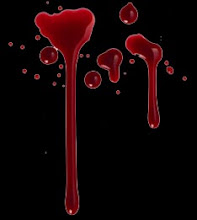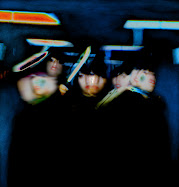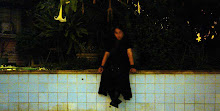Paintings for the blind I
Blind people have been incapable of appreciating (for obvious reasons) pictorial art during its whole history. And here I ask, how much can we say we have indeed "seen" when observing some artist’s oeuvre? Is it that, in reality, we have decodified/interpreted what it’s shown when we think we are understanding the meaning(s) of a certain piece?
I am intrigued by the loss (if there is any) when the image is translated into words (first, in our minds) and then into text: I find fascinating the importance is given nowadays to art critics or curators, sometimes assumed as being the only ones (or at least, who we think are the more indicated) that have enough experience and wisdom as for to "explain" what is going on in the oeuvre and that we are not capable of seeing in totality. We know that this explanation might say things the artist never meant to say; it’s true we could see aspects the artist never saw (maybe just being applied directly from the subconscious), thing that could enrichen his piece, contributing with a certain meaning he, maybe, never had the intention in including (or never actually did).
I am intrigued by the loss (if there is any) when the image is translated into words (first, in our minds) and then into text: I find fascinating the importance is given nowadays to art critics or curators, sometimes assumed as being the only ones (or at least, who we think are the more indicated) that have enough experience and wisdom as for to "explain" what is going on in the oeuvre and that we are not capable of seeing in totality. We know that this explanation might say things the artist never meant to say; it’s true we could see aspects the artist never saw (maybe just being applied directly from the subconscious), thing that could enrichen his piece, contributing with a certain meaning he, maybe, never had the intention in including (or never actually did).
Paintings for the blind I shall consist of canvases but, opposing what usually happens in galleries ("do not touch the paintings") in here, close contact with them is promoted, since they will have a text in Braille with some of my writings. The figure exists visually and textually, since I want to show its similarities and differences in the same piece (I conceived them both and the subjects are the same: mainly autobiographical, confessional); blind people will be able to read the text we can’t read; we will be able to interpret the images they can’t see.

Decapitation - 2008
Paintings for the blind II
Is it that information is molded by the same senses that incorporates it? What happens if a certain type (or form) of information, that normally would be conditioned to enter by one sense -in a synesthesia manner - so it can enter through another, in this specific case, if images are "translated" into sound?
Obviously for us, this information will be uncomprehensible, losing all its meaning.
But now I wonder if this only happens because of our physical limitations... That there could exist beings that would be able to process this type of information; as a bat (even if the example might not be the best, since they use the bouncing of sound to measure distances) they could reconstruct the world, what we will be seeing, by listening it.
As it happens, in a way, with Braille. Most people don’t know how to read it; the information that it contains can’t be accessed. But to blind minorities, this information is accessible (if the they know the reading technique); with touch, they can "read", just as a synesthesia, an image can be described by a tactile media... But, what is it lost when doing this change, this translation?
It is said that energy is the same throughout the universe; that the only things happening is a constant exchange of it between its constituents, that is never lost, that is only transformed... Can it happen the same with information? Can it just constantly be transformed and never be really lost, and then, what happens is that we don’t have the means for understanding it when it doesn’t enter the sense it would usually incorporate/process it?
This piece intends to discuss this questions through straightforward interaction with the spectator, which will touch the braille on the surface (text that is indeed describing this same event, that of the spectator touching the piece)... Spectator that is also "observed" by a webcam - the text actually describes what the camera is recording capturing images and movements (in real time) for then to be sent (the video) to a processor that lays at its side and through a certain program (Max/Jitter) proceed to change it into sound.
The spectator ends up listening to his own "image" without knowing he is doing so.
Hermeneutical approach of the work:
Comprehension (in this case specifically, of the art piece) is based on the previous awareness of the laws that govern the "game" beforehand; a game in which our previous participation is assumed as pre-judgement or prejudice (by knowing the laws before entering the game) and our partiality (we understand the art piece from our own subjectivity/we communicate with "the other" through this conventions) then being the structures that allow comprehension itself. And since this is a game in which the values of truth wouldn’t be worth beyond the frontiers of the game itself (art or human interrelation) the scientific criteria rooted in the concepts of "truth" or "false" wouldn’t be applicable in this context.
In Hermeneutics its considered that all types of comprehension are interpretative (I understand that you feel pain because I interpret - I relate/I have felt the same - what you are trying to say, being that through inarticulate sounds or a structured phrase) and since interpretation always involves the exchange in between the unfamiliar and the familiar, all interpretation is always a translation; it being as to move the content of a text from one language to another, or a mental concept from one person to another, o a "way of life" to some other person never exposed to it before, etc. One could say that the space of the "horizon fusion" is the context in which this translations are constantly occurring; as a necessary step for this fusion.
To des-cifrate, de-codify, dis-cover, "open"; hermeneutics can be a valid method for comprehension, and Paintings for the blind discusses this subjects through art... About the reach of human understanding: of the world, and among ourselves.
http://autodios.blogspot.com/2007/07/pintura-para-ciegos.html
Self Portrait - 2007
TEXT IN BRAILLE (in the canvas/translated from spanish):
An illuminated space; tall lights, soft white walls, and the voices of the people that surround you have been accompanying you until you arrived here.
The gallery guards oeuvres of different artists; some extremely colorful, other, somewhat sober.
But all of them want to tell you something.
In silence, they await your sight.
Every once in a while a person passes by, stopping for a while, to observe them.
Watches them for a while; tries to understand, questions itself, or enjoys for a moment.
But in silence they have always stayed for you.
You have approached them; have touched their surface…
But they were only textures, insignificant plain surfaces, or simple irregularities.
Another person was looking at a painting, and now is walking behind you.
Just like that you arrived here and now you touch this surface with curiosity.
It has no color and it doesn’t have much contrast against the wall that is behind it.
But now your face is illuminated with the white light coming out of its frame.
And it turns out that these pieces are only safeguarding thoughts, dreams, or emotions.
Keeping secrets in safes expecting us to bring the keys with us.
Awaiting us for to uncover their secrets,
They have been waiting for some time now.
We are their reason to be.
And that is why, today, I give you the keys for this one.
Each one of the lines that cover this canvas wants to tell you a story:
That without registry, what you’ve lived will disappear…
Because each one of the oeuvres that cover the gallery
Are keeping memories and dreams.
As your body, they treasure experiences.
Confronting time that inexorably passes,
They have been marked by the world of their creator.
And so now
You touch the blueprints I’ve left for you:
"The lack of consciousness is the end
Death, just an eternal present
Since, with no mind you won’t be able to dream with the future
Nor remember the past…
Death is only being aware of now because without the body there can’t be no registry,
Nor imagination left."
And it is that same body which is allowing us to communicate, you and me.
While you are reading with the tip of your fingers and are listening to incomprehensible sounds.
Let me tell you a secret:
These sounds are what the rest see of you.
Touching carefully, moving the arm by the canvas; your clothing and your skin…
Yes, it’s all there.
Feel your image.
Listen to it.
They don’t understand it but now you know.
And then you are finishing reading this phrases…
While you try to understand, questions yourself, or enjoy the moment.















